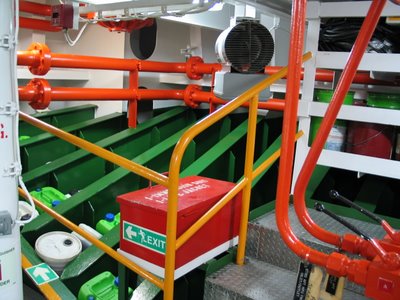Gould Engine Room
We got a tour of the engine room from Mike, one of the ship's engineers. Other than being noisy, this was a beautiful sight. Every thing was so clean. All the systems were painted with colors separating out their functions. It was so clean it felt like you could eat off the floor.
 This is the air intake for one of the Catapiller 6-cylander engines. Below is the engine itself.
This is the air intake for one of the Catapiller 6-cylander engines. Below is the engine itself.

Two parallel engines turn each propellor. They are constant speed, about 900 RPM and fueled by diesel.

This is the transmission that reduces the speed of the shaft from 900 rpm to 250 rpm, the speed of the propellors. The props have a variable pitch arrangement like many airplanes so power can be added by digging into the water by changing the pitch.
 I believe this is the fire pumping system.
I believe this is the fire pumping system.

This is the starboard hind corner of the boats's hull form the inside. I liked this shot becasue of the composition, not that it shows the mechanics of the operation. You can see the heavily reinforced beams for dealing with Antarctic ice.

These motors provide the hydraulic power for turning the rudders, and probably adjusting the propellor pitch, too.

This is the rudder turning mechanism. The rudders stick down directly below two of these servo-motors. Most of the control of the boat is done by computer. Watching the pilot steer is mostly him adjusting the computers. Except, of course, around the ice or docking.
 This is the air intake for one of the Catapiller 6-cylander engines. Below is the engine itself.
This is the air intake for one of the Catapiller 6-cylander engines. Below is the engine itself.
Two parallel engines turn each propellor. They are constant speed, about 900 RPM and fueled by diesel.

This is the transmission that reduces the speed of the shaft from 900 rpm to 250 rpm, the speed of the propellors. The props have a variable pitch arrangement like many airplanes so power can be added by digging into the water by changing the pitch.
 I believe this is the fire pumping system.
I believe this is the fire pumping system.
This is the starboard hind corner of the boats's hull form the inside. I liked this shot becasue of the composition, not that it shows the mechanics of the operation. You can see the heavily reinforced beams for dealing with Antarctic ice.

These motors provide the hydraulic power for turning the rudders, and probably adjusting the propellor pitch, too.

This is the rudder turning mechanism. The rudders stick down directly below two of these servo-motors. Most of the control of the boat is done by computer. Watching the pilot steer is mostly him adjusting the computers. Except, of course, around the ice or docking.

1 Comments:
Hi! I just found your blog and I found it really interesting, so I'll try to come and read it as often as possible. :) If I could, I'd add you to a "friends lists" here in Blogger! :D
Anyway, great blog and beautiful pictures! I'd love to be in Antartica! :D
Greetings! ;)
Post a Comment
<< Home